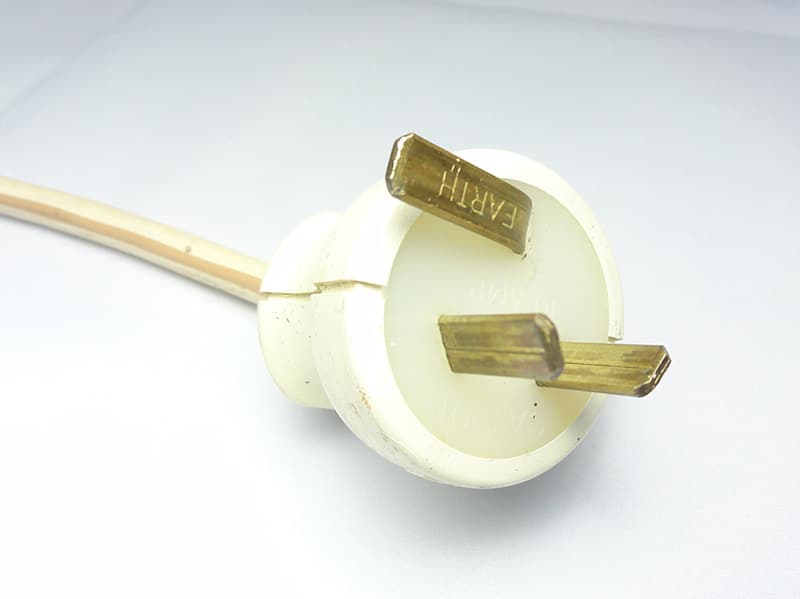
On The Bench: 10 Stupid Things You Shouldn’t Do!
This issue we’re publishing the tech’s Top 10 – handy tips to prevent death by electrocution, fire etc.
Text: Rob Squire
In my music room I have a framed photo of Albert Einstein that captures him talking into a pristine RCA 77DX ribbon microphone. I like to think he had musicians and recording engineers in mind when he said “Two things are infinite: the universe and human stupidity; and I’m not sure about the universe.” I also like to think he made this famous quote speaking into that nice ribbon mic on the very occasion that this photo was taken. This issue I thought I’d compile a list of the 10 stupidest things we should avoid falling foul of in the studio or on stage. Feel free to nod in knowing appreciation as we stumble, trip and stagger through the list.
1: FUSES ARE NOTHING BUT TROUBLE
There is no single component that consumes more time on my ‘free advice’ hotline than questions about fuses. I hear all too often the frustration that gives rise to the industry standard approach to a blown fuse: ‘wrap foil around it and jam it back in’. Sure we’ve probably all done this – it’s 10:50pm on a Saturday night, the band’s on stage at 11 and the Marshall head has just popped a fuse. What else are you supposed to do?
Well, regardless of the old adage, ‘the show must go on’, and despite what it seems, fuses aren’t just there to drive us all to despair. They actually serve to protect both the equipment and the people using it. This fact was made all too clear to me only last week in spectacular fashion when my workshop bench power supply caught fire. I bought it secondhand about 10 years ago and it’s always done its job well, so I’ve never had reason to look inside or question its construction. This week it was sitting there powering up some nice Electrodyne modules when I looked up to see smoke billowing from the unit’s slotted lid, quickly followed by a small lick of flame. Once the pressing need to pull the mains power out of the unit and get it outside had passed, I had the chance to pull it apart and look inside to see what had happened. Lo and behold, this thing had been built without incorporating any mains fuse. This is not only illegal, it’s downright stupid. In this instance the transformer had failed, and since there was no fuse to blow, it just kept sucking mains current, heating everything up to the point where it finally caught fire. This story highlights one of the fundamental and practical roles of a fuse: it prevents things failing with catastrophic results.
Of course, the thing about fuses that leads to frustration is that sometimes they blow for seemingly no apparent reason, or at least no reason that coincides with an apparent fault within the equipment. Also, just like anything else, a fuse can simply be faulty in and of itself. Not all fuses are created equal and sometimes that hair-thin wire inside just snaps off. This leads to the proposition that replacing a blown or broken fuse is an entirely reasonable step to take. Now back to our gig: it’s 10:55pm and you need a fuse pronto. Of course you have a couple of spares in the gig bag, don’t you? I mean, you have spare strings and probably even a spare guitar lead so naturally you’ll carry a couple of spare fuses of the correct type for your amp, right? Forget the Alfoil – you only use Alfoil for cooking!
2: I CAN’T HEAR IT!
Whether or not it’s at a live gig or a studio session, sometimes audio just disappears in the headphones. Even though you’re sure playback is happening, for some reason the audio has mysteriously gone missing. We’ve all experienced it. You’ve probably knocked a switch somewhere or a plug’s fallen out and so you’re hunting down the source of the trouble. The heat is on of course – isn’t it always? – and so you’re furiously flicking switches, cranking dials and wiggling connectors, and then presto! It was just that source select button that you must have knocked earlier. Unfortunately, this innocuous discovery sometimes coincides with pumping 140 decibels into those headphones you, or the patient vocalist you’re working with, is wearing. At other times the rejuvenated signal is headed straight for those expensive main monitors like a tweeter smoking tsunami. That’s right, you did try turning up the monitor volume to 100% seven steps back while hunting down the missing audio, before you discovered and flicked the pesky source selector switch. When you’re tracing lost signals like this, take off the headphones and power down – or at least turn down – the monitors.

3: HO HUM
We’ve all heard of (ie, read or talked about) earth loops and plenty of us have actually experienced them. Like so many problems in life, there are usually a couple of solutions available that eliminate earth loops. One of these is exceedingly dangerous and downright idiotic: cutting off the earth pin on the offending power lead. For those afraid of commitment, yet predisposed to electrocution, you might just choose instead to fold the earth pin over. Either way, you risk killing yourself or others. Mains power earths exist for a reason that has nothing to do with audio quality and everything to do with safety. Every earth loop problem can be solved in a way that is safe and leaves the mains earth pin intact. Feel free to fiddle about with the wires inside XLRs and TRS plugs; just don’t fiddle with mains plugs.
4: LEAD ON
Electric guitarists take note (everyone else can jump this section): if you have an amp that consists of a separate head and cabinet, then you’ll be using a speaker lead to connect them, right? A speaker lead is not a guitar lead… you do realise this I hope? Sure, they both have tip and sleeve connectors, and sure, a guitar lead will work to some degree between the amp head and speaker cabinet but it isn’t a lead that’s capable of transferring the voltages and currents involved. If you do this and you’re lucky you’ll just waste a tad of power in the cable. Less lucky and you’ll burn the cable out. But if you’re really unlucky you’ll blow up the amp. There’s a cable for every job – use the right one.



5: THE GREY IMPORT
I know, I’ve harped on about this before but it’s such a common occurrence that I need to slap you all again. The simple fact is that in the USA mains power is 115Vac. In Australia it is 230Vac. That’s double the Volts folks and if your grey import is set for 115Vac when it lands fresh from the USA and you plug it into Australia’s mains supply, the experience will be overwhelming… for your new shiny toy and your pocket as well. If fortune is still on your side, you’ll blow a fuse. However, chances are you’ll do a lot more damage than that, damage that’s not covered by any sort of warranty. Oh, and please also note: simply using an Australian power lead or changing the rating of the fuse does not magically convert the unit’s operating voltage. Stop and think before plugging in anything you’ve imported from the USA, unless it’s a Twinkie.
6: WRONG AGAIN
Speaking of wrong voltages: increasingly, manufacturers are turning to the plug-pack or wall-wart for power. Plug-packs are not a universal black box of power. Different machines need different voltages, AC or DC supply and consume different amounts of current. There are devices on the market that will be destroyed if you plug in the wrong plug-pack, or a pack that sports a reversed plug orientation. Now, while I’ll admit this issue clearly suggests some rank stupidity on part of the designers of these products as well – yes, we can all share the stupid hat – nevertheless, beware the plug-pack. Read the label next to the socket to ensure that all the specifications of the plug pack, including the polarity of the connector, match the unit before you plug it in. As a repairer, when someone is arranging a visit to the workshop of any plug-pack powered unit I always insist that the one currently being used with the unit is sent along as well. Not only does this save me having to rummage around in my carton of assorted plug-packs for the correct type, it also allows me to rule out any faults caused by the wrong one being used.
7: DUST BUSTER
The manufacture of condenser microphones has transformed from an esoteric European black art into a mass factory production, with the resulting benefit of them becoming available at low cost. However, nothing has changed as to their capsule’s sensitivity to contamination by dust. The high voltages, gigaohm impedances and microscopic dimensions involved in condenser capsules means that a tiny amount of dust, particles or general crud can stop them working, or at least working noiselessly and consistently. If you have a condenser mic and you like to leave it on a stand ready for action 24 hours a day, at least find a nice plastic bag to slip over it when you’re not using it. If your mic came with one of those slip-on foam pop filters then give serious thought to throwing it away and getting a real pop filter. Not because it might sound better but because most foam filters degrade quite quickly and begin to rain tiny foam particles down through the grille and onto the capsule. This is aggravated even further when you slide the pop filter on and off regularly – the grille screen typically acts like a cheese grater, scraping off the foam particles through the grille and onto the capsule.
8: FALLING OVER
Just yesterday a client returned a guitar amp head to me that he had picked up only two days earlier. “It was sounding great,” he said. “I was really going for it… jumping around, and then the next minute the amp slid off the top of the quad box and smashed on the floor. Now it doesn’t sound so good.” If something can fall over, slip off the table, snap, be tripped over or generally broken it will happen wherever musicians are involved. Call me a bigot but it just seems to be fact that musicians will realise the potential danger in any situation. Gaffa tape is the universal panacea.
9: POWER ON
Okay, I admit this one seems unbelievable, but I’ve seen the evidence and got the photos here to prove it. Fate has allowed the humble figure-eight mains power lead to mate seamlessly with the male XLR plug leading to catastrophic results. If the authorities catch wind of this it could mean the demise of the male XLR as, by the book, nothing should physically mate with any sort of mains power connector unless it’s designed to accept mains voltages. Just because a plug and socket seem like a match made in heaven doesn’t mean you should bring them together. If you have figure-eight mains leads don’t be tempted to plug them into male XLRs, it’s unnatural.
10: OLD SCHOOL
If the lesson wasn’t driven home firmly enough by Meatloaf’s opening performance at the recent AFL Grand Final, let me make one thing abundantly clear: old is not necessarily good. Purchasing equipment based on a sentimentality that’s usually reserved for old folks is not a smart idea. There’s plenty of vintage audio equipment that was not particularly good in its day and won’t be in the future. Not all new equipment is great either of course, but that’s precisely the point. Everything that’s new eventually grows old, so will all the $50 compressors built this year eventually become vintage classics 50 years from now? No, they won’t.
11: ROCK ’N’ ROLL
Sure, the title of this article may have convinced some AT readers that this ’ere list would only go to 10, but it wouldn’t be rock ’n’ roll if a list of ‘10 dumb things’ didn’t crank up to 11, so let me just close with something that, if nothing else, is a reminder to myself: don’t make assumptions. We work in a complex world that combines technology with technique, machinery with magic, all of it creating lots of potential for things to go wrong. And it’s when things go wrong that we often make our biggest mistake – we make assumptions. Whether troubleshooting a faulty piece of equipment or mixing a masterpiece, assumptions can divert us from seeing or hearing the truth, wasting time, effort and sanity. Rule number one: assume nothing.
Thanks to the members of AARG (Australasian Audio Repairers Guild) for their insights.
Rob Squire runs Pro Harmonic

















RESPONSES